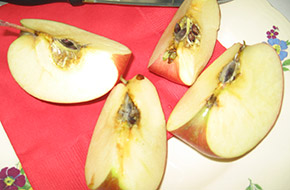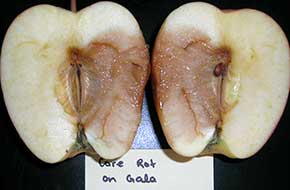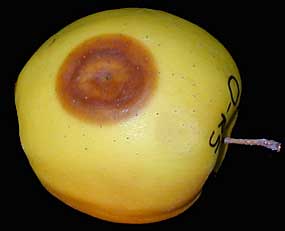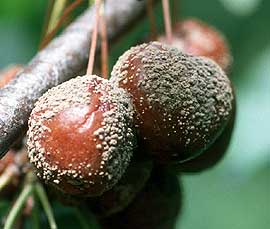Post-Harvest Rots Initiated in the Orchard
General Description
Many post-harvest rots of pome and stone fruit are actually initiated in the orchard. Symptoms are not always evident at harvest and may develop during storage and shipping. There are many practices that can be implemented on the farm to reduce losses from orchard-initiated post-harvest rots.
Apples & Pears
Many storage rots begin in the orchard and can be controlled at this level. There are often no pre-harvest symptoms, so identification is possible only after symptoms develop in storage. In some cases the symptoms are internal and discovered only after the fruit is cut open.
Packinghouse programs are designed to identify specific orchards or areas that are most susceptible to post-harvest rots. See your horticulturist for more information on the need to apply controls in your area.
Post-harvest diseases of apple and pear fall into three general categories:
-
Blossom infections
-
Fall lenticel infections
-
Infections that occur at harvest as the result of injury to the fruit, such as stem punctures.
All of these are controllable to some degree by orchard management programs.
Blossom Infections:
A number of fungi cause fruit infection by first colonizing or infecting the blossoms. The incidence of infection is much more prevalent in a wet spring. There are often no visible symptoms of disease until after harvest. In some cases infected fruit may colour and fall prematurely in the orchard.
Three common rots in this category are:
-
Moldy core – Alternaria spp. and other fungi
Symptoms include mold growth in the core region of the fruit. The rot does not spread into the flesh, and can be seen only when the fruit is cut open. Varieties with an open sinus extending from the calyx to the core are more susceptible to moldy core.
-
Dry eye rot / Blossom end rot - Botrytis spp.
Initial symptoms include a reddish discoloration at the calyx end. A soft, water soaked lesion forms which expands to several mm and dries out forming a sunken brown lesion. If infected fruit are harvested, they will have an increased incidence of Botrytis rot in storage.
-
Core rot - identification unconfirmed
A wet core rot that spreads into the flesh of the apple has been a recent problem in ‘Ambrosia’, ‘Gala’ and ‘Red Delicious’ apple.
 |
.jpg) |
| Moldy Core of apple (Bill McPhee) | Dry eye rot of apple. (BCMA) |
 |
 |
| Core rot of 'Gala' apple (Bill McPhee) | Bulls eye rot of apple. (Peter Sholberg, AAFC) |
Cultural Controls:
General sanitation in the orchard helps reduce inoculum. The spores of these fungi are prevalent in the ground litter and in the tree. Therefore, mowing and clearing of leaves, fallen fruit and prunings can help reduce potential sources of infection.
Chemical Controls:
These fungal pathogens can be reduced with spring sprays. Although there are no chemicals registered specifically for these fungi, carefully selected scab fungicides at the pink to petal-fall stages will provide some control. See table below for more information.
Fall Lenticel Infections:
Several fungi can enter the fruit through weak lenticels and wounds, and may not show symptoms until after a period of storage. The most common in B.C. are:
-
Bull’s Eye rot – Neofabraea spp.
Symptoms include circular, brown lesions with a target-like appearance on fruit. This rot is caused by the same fungi that cause perennial and anthracnose cankers. Spores may be spread from cankers to fruit any time during the growing season, but the risk of infection is greatest close to harvest. This disease is more severe in years with frequent rains at harvest. -
Phacidiopycnis rot – Potebniamyces pyri. (Pears only)
This fungus is a weak canker-causing pathogen on pear trees. Spores produced in cankers cause infection at the stem and calyx end of pear fruit as well as in skin wounds.
Other fungi that occasionally cause fruit infection in the orchard include:
-
Snow mold rot – low temperature basidiomycete
Formerly called Coprinus rot, this disease is associated with poor handling of bins in the orchard. Clumps of dirt and grass transferred to the bin carry fungi which contaminate dump water and cause fruit infections. -
Blue mold rot (Penicillium spp.)
Penicillium spores are ubiquitous in orchards and are capable of infecting via weak lenticels or through skin punctures that occur during harvest. -
Mucor rot (Mucor sp.)
Mucor does not appear to attack through lenticels but is most commonly associated with stem end infections. -
Sphaeropsis rot (Sphaeropsis pyriputrescens)
This fungus produces a rot similar to Botrytis spp. It is found on pear and apples but is more important on apples.
.jpg) |
.jpg) |
| Figure 3. Blue mold of apple. (AAFC) | Figure 4. Mucor rot of apple. (AAFC) |
Cultural Controls:
Cleaning up the cankers in the trees is the most effective control for Bull’s Eye and Phacidiopycnis rot. Since snow mold rot has been associated with soil and grasses or weeds being transferred from the orchard floor to the bin, careful handling of bins in the orchard should help reduce this problem.
Chemical Control:
There are no fungicides registered specifically for many of these diseases. Some pin point scab sprays will reduce the incidence in storage. Captan is registered for control of bull's-eye rot and can be applied up to 7 days before harvest. See table below for more information.
Infections that occur during harvest as a result of injury:
Fruit in the orchard supports a variety of fungal spores on the surface. These spores are opportunistic and will enter the fruit through wounds. Botrytis and Penicillium spp. are two fungi that commonly infect through wounds at harvest. These pathogens continue to develop and spread in storage, and are responsible for significant post-harvest losses in the packinghouse.
At the time of harvest it is important to handle the fruit gently. Fruit that is transferred to the bins roughly will experience puncture wounds, bruising and other skin breaks. One common wound that is associated with stem end rot is a loosening of the stem-to-apple connection during picking. This results from pulling the apple away from the tree rather than using a twisting motion while holding the stem firmly and steady. This type of injury is most common in the variety Gala.
Cultural Control
Train pickers to handle the fruit very carefully while harvesting. Remove the fruit by gripping the apple and stem together and separating the apple with pressure on the abscission layer between stem and spur, not by pulling down on the fruit.
Carefully transfer fruit from the picking bag to the bin. This requires gently placing the full bag on the fruit already in the bin and gently pulling the bag up, releasing the apples. Transporting fruit within the orchard and to the packinghouse should be done carefully to avoid bruising. Never pick windfalls into the bin.
Stone Fruit
As with apple orchards, stone fruit orchards are full of orchard-generated fungal inoculum. Unlike apples, however, stone fruit are much more vulnerable to breakdown and fungal attack immediately after harvest.
Important post-harvest disease problems of stone fruit in BC are:
-
Brown rot – Monilinia spp.
-
Botrytis rot – Botrytis cinerea
-
Alternaria rot – Alternaria spp.
-
Rhizopus rot – Rhizopus sp.
-
Mucor rot – Mucor sp.
Correct identification of stone fruit decay problems is critical to selecting the correct preventative control strategies in the orchard. If you are unsure which diseases are present, contact your field advisor or submit a sample for diagnosis.
Brown rot is common on all stone fruit in the orchard. Blocks of fruit delivered to the market from orchards with heavy fruit infections in the tree will be very prone to post-harvest rot at the market. Some export markets do not allow any brown rot in the fruit. Inoculum can be found in the litter beneath the tree and in mummified fruit left in the tree from the previous year. Refer to the section on brown rot in this chapter for more information on management, including registered fungicides.
Botrytis rot of mature cherry fruit occurs commonly in B.C. cherry orchards, and can be mistaken for brown rot. Fruit develop a firm brown decay and become covered with light brown spores. Botrytis will grow on aborted fruit and trapped leaf debris within the clusters, which then spreads to adjacent fruit. Fruit from infected blocks has a high potential for causing fruit rot problems during post-harvest transport and marketing.
.jpg) |
 |
| Botrytis rot of cherry fruit (BCMA) | Brown rot of cherry fruit (BCMA) |
Alternaria Rot is found mainly on cherries and apricots. It is common in split pits of fruit, rain-split cherries and in insect feeding injuries. It also infects aborted cherry fruit, and can spread into attached healthy fruit. On cherry, Alternaria usually shows up post-harvest as a dark green to black growth on the nose of the fruit. Early infections on apricot appear as red rings on the fruit and can occur when the fruit is still green. As the fruit matures the centre of these rings becomes sunken and brown. In these cases fruit is culled at packing or not picked.
Rhizopus rot is most common on peaches and nectarines (Fig. 7). This rot appears as large masses of black-grey fungus extending outward from the fruit in a whisker-like effect. Symptoms rarely develop in the orchard unless fruit is left to tree ripen. Because this fungus is a wound parasite, breaks in the skin favour disease development. Fruit picked and shipped to market becomes vulnerable to decay as the fruit ripens and sugar concentrations increase, especially if temperature during shipping is allowed to go above 10°C. One diseased peach in a container can infect many other fruits in a few days.
.jpg) |
|
| Rhizopus rot of peach. (Peter Sholberg, AAFC) |
Mucor Rot:
Mucor rot is less common on stone fruit. It has the appearance of stiff salt and pepper coloured whiskers on the fruit surface after the rot has progressed deep into the fruit. The spores are spread primarily by water, making the dump tank an important source once it has been contaminated by soil. The fungus is able to grow at 0°C and will rot fruit in cold storage.
Diagnosis of post-harvest rots
Correct identification of fruit rot problems is critical to selecting the correct preventative control strategies in the orchard. Contact your fieldman or crop advisor to assist with identification of any new or unusual disease problems, or submit a sample to the provincial plant diagnostic laboratory in Abbotsford. Information on the incidence of post-harvest rot in your crop should also be available through the packinghouse staff and/or feed back from the market.
Management
Cultural Control
General Management Techniques to Reduce Post Harvest Fruit Rots:
Consider post-harvest decay control as an integrated pest management strategy. Cultural controls are important, and options for chemical control are often limited. The following are general management techniques that will help to reduce the occurrence of rots in both pome and stone fruits.
-
Focus on nutrient programs that improve fruit quality. Apply calcium sprays to improve fruit resistance to disease.
-
Control insects that may act as vectors of disease spores.
-
Prune out cankers in varieties or blocks prone to bull’s eye rot or phacidiopycnis rot.
-
Prune for increased air flow to promote faster drying and better spray penetration.
-
Shorten current season’s growth to reduce fruit cluster formation on cherry varieties prone to heavy clusters.
-
Ensure good spray coverage into heavy cherry clusters before they close up.
-
Practice orchard sanitation and “soft handling” of fruit.
-
Harvest fruit at proper maturity
-
Do not put windfalls into bins.
-
Use clean bins. As much as practical, minimize the amount of soil and plant debris brought into the packinghouse on the bottom of bins.
-
Keep fruit cool after harvest, i.e. keep bins in the shade.
-
Minimize time between harvest and delivery of fruit to the packinghouse.
Management Strategies for Common Post-Harvest Rots
In addition to following general management techniques to reduce post-harvest rots, the following practices may be helpful for specific diseases. Follow label instructions and observe pre-harvest intervals for all fungicides. Rotate fungicides for resistance management.
|
Crop |
Disease |
Season |
Source |
Control |
|
Apples and Pears
|
Moldy core |
Blossom |
Orchard Litter |
A reduced incidence of moldy core in blocks sprayed for scab in the spring has been observed. |
|
Dry eye rot/blossom end rot |
Blossom |
Leaf litter |
80% bloom to petal fall spray with scab fungicides that also control Botrytis will reduce this problem (e.g. Vangard, Scala on apple) |
|
|
Core rot |
Blossom |
Unknown |
Unknown. Spring scab sprays may help to reduce incidence. |
|
|
Bull’s eye rot |
Fall |
Tree cankers |
Captan is registered for control of bull's-eye rot and can be applied up to 7 days before harvest. Remove cankers. |
|
|
Snow mold rot |
Fall |
Soil, orchard grasses |
Avoid contaminating bins with grasses or soil |
|
|
Phacidiopycnis rot |
Fall |
Pear tree cankers |
Identify and remove cankers. |
|
|
Blue mold, Botrytis |
Summer/Fall |
Orchard litter |
Scala (pyrimethanil) is registered for orchard application to help control of post-harvest rots of apple. Apply 14 days before harvest. Late season pinpoint scab sprays with Vangard (cyprodinil), ziram or captan will reduce the incidence in storage. Observe Pre-harvest intervals. |
|
|
Blue mold, Botrytis and other rots |
Post-harvest. |
|
Several fungicides are registered for control or suppression of post-harvest rots of pome fruit in the packinghouse. Academy (difenconazole + fludioxinil) - controls botrytis, blue mold, alternaria, bull's-eye rot |
|
|
Stone Fruit |
Brown rot |
Spring/ summer |
Mummified fruit and wood infections |
Control brown rot in the field to reduce post-harvest losses. Refer to the brown rot description and spray schedules for information on disease management and fungicides. |
|
Botrytis rot |
Spring/ summer |
Orchard litter |
Fontelis (penthiopyrad) is the only fungicide registered for control of botrytis rot of cherry and other stone fruit. Other fungicides used for brown rot will also help to control botrytis, including Bravo, captan, Elevate, Pristine, Cantus, Sercadis and Fracture. Blossom is an important spray timing for management of botrytis rots. Note: botrytis resistance to Senator and Rovral is fairly widespread. |
|
|
Alternaria rot |
Spring/ summer |
Orchard litter |
No fungicides are specifically registered for control of alternaria on stone fruit. Other fungicides used for brown rot will also help to control alternaria, including Bravo, captan, Elevate, Pristine, Cantus and Sercadis. |
|
|
Rhizopus rot |
Spring/ summer |
Orchard litter |
Pristine is registered for control of Rhizopus rot. Apply the day before harvest for best results. |
|
|
Blue Mold, Botrytis rot, Brown rot, Rhizopus Rot |
Post-harvest. |
|
Scholar (fludioxonil) is registered for control of post-harvest rots of stone fruit in the packinghouse. |
Updated January, 2017
